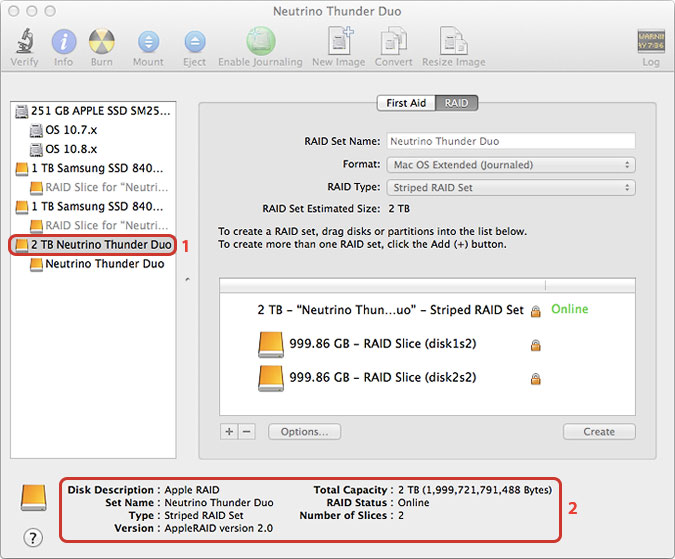- Mac Os X Software Update
- Older Mac Os X Software
- Latest Mac Os X Software
- Mac Os X 10 Download
- Setup Software Raid 10 Mac Os X
Create a disk set using Disk Utility on Mac. You can create a Redundant Array of Independent Disks (RAID) set to optimize storage performance and increase reliability in case of a disk failure. You can also create a set that concatenates smaller disks to act as one larger disk. Aug 04, 2011 Hello, Today I am going to be showing you my 4x RAID 0 Setup in my 2008 Mac Pro. The RAID 0 consists of 4x 500GB 7200RPM 32MB/Cache SATA. I have been using RAID on Macs and PCs since 1999, and I have done it in software and 7-8 different kinds cards on various OSes. I will tell you two reasons why I won't use software RAID anymore: first, if a drive has an issue and doesn't mount as expected, it will break the RAID volume, and correcting the issue takes more time and is prone to mistakes; secondly, RAID on software uses.

Mac Os X Software Update
| Click here to return to the '10.4: How to create a partitioned RAID setup' hint |
Seems to me that it would make more sense to just create a single raid array, then partition the newly formed disk:
Use RAID5 (striped) on the three disks. Creating a new virtual disk. Now partition that virtual disk into 3 volumes as you see fit. You'll get more redundancy that way too.
Now if you have two disks and want three volumes, do a mirror set, then partition that one mirror set to 3 volumes. What you're doing is asking for trouble later.
Does this work with SATA I tried to partition a mirrored RAID and was unable.
The RAID option tab did not show up in Disk Utility.
Not quite... RAID 5 isn't possible through software (apple's at least), nor is slicing an array. The OG post is the only way to end up with multiple partitions + RAID.
Shouldn't this be called creating RAID from partitioned disks? This may be functional but I think this could cause a problem if a drive ever fails as you would lose all of your volumes
This feels like a bad idea. Can the user actuallly confirm that if a drive fails the OS successfully rebuilds the data AND the partitions?
Or would you need to manually recreate the partitions prior having the RAID array repair a faulty drive.
Good idea - but it just feels like a bad one. At least I wouldn't be trying it out without thorough recovery testing.
---
__
http://www.step.net.au

Older Mac Os X Software
Disk Utility User Guide

Latest Mac Os X Software
You can create a Redundant Array of Independent Disks (RAID) set to optimize storage performance and increase reliability in case of a disk failure. You can also create a set that concatenates smaller disks to act as one larger disk.
In the Disk Utility app on your Mac, choose File > RAID Assistant.
Select a set type:
Striped (RAID 0) set: A striped RAID set can speed up access to your data. You can’t create a RAID set on your startup disk; you must first start up your computer from another disk.
Mirrored (RAID 1) set: Protect your data against hardware failure with a mirrored RAID set. When you create a mirrored RAID set, your data is written to multiple disks so the information is stored redundantly. You can’t create a RAID set on your startup disk; you must first start up your computer from another disk.
Concatenated (JBOD) set: Increase storage space with a concatenated disk set. If you need one large disk, but you have several smaller disks, you can create a concatenated disk set to use as one large disk.
Select the checkboxes of the disks you want to include in the set.
For each disk, click the pop-up menu in the Role column and choose “RAID slice” or “Spare” to designate the disk as a standard member or spare in the set, then click Next.
Enter a name for the RAID set in the RAID Name field.
Click the Format pop-up menu, then choose a volume format that you want for all the disks in the set. (See File system formats available in Disk Utility.)
Click the “Chunk size” pop-up menu, then choose a disk chunk size that you want used for all the disks.
When you create a striped set, chunks of data from the same file are distributed across the drives. Ideally, you want data distributed across drives evenly and at an optimum size so that it can be efficiently accessed. If you want high data throughput from your set, choose a smaller chunk size so that data is spread across the drives and one drive can be accessing data while another is seeking the next chunk. With mirrored disk sets, choose a chunk size that matches the data you’re accessing. For example, when working with video files, your Mac is accessing large chunks of data, whereas when using a database of many small records, your disks may be accessing smaller chunks of information.
If you are creating a mirrored RAID set, select the “Automatically rebuild” checkbox to allow the set to be automatically rebuilt when member disks are reconnected.
Click Create.
Click Done.
Mac Os X 10 Download
If you have a Mac Pro with a Mac Pro RAID card, use RAID Utility. It uses the RAID card for better performance and to create more types of RAID sets.